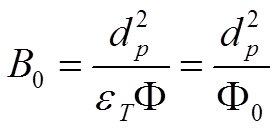Chromatographic Column Resistance Factor
The equations on the previous page originate from chemical engineering and geology disciplines. As mentioned on a previous page, in the early days, chromatographers took a slightly different approach by using chromatographic solvent velocity since it can be measured easily. Chromatographic permeability (J.H. Knox et al., Chromatographia, 10, 279 (1976)) was defined as given in equation 2.7 on a previous page and shown here again:

Substitution of the lhs part of the K-C equation (2.9 or 2.10) leads to equation 2.11:

Knox defined the chromatographic column resistance factor Φ0 (equations 2.12) as:

A superior quality HPLC column will have a chromatographic column resistance factor Φ0 around 700 which means an interparticle porosity of 0.4 and a total porosity of 0.7.
Again, it is imperative to note the differences between the solvent velocity definitions used and the column permeability derived from it. The indices are important.
